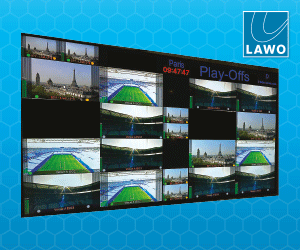Content consumption is at an all-time high, but advertising is at an all-time low and monetisation has become challenging. MENA leaders discussed how they are revisiting business models in a rapidly changing media environment.
The CEO panel at the ASBU BroadcastPro Summit is in essence not just the culminating debate of the conference, but also the platform where regional market makers discuss how they have revisited their business models over the year, in a climate where the regional economics have changed forever.
Moderator Karim Sarkis, Partner, Entertainment and Media at Strategy&, has been known to ask challenging questions on this panel and has always managed to extract answers from those in the hot seat. Joining us this year as speakers were Amanda Turnbull, VP General Manager MEA at Discovery Communications; Danny Bates, CCO and co-founder of STARZPLAY; Hamoud Al Rumayan, CEO of Intigral; Manoj A Mathew, Territory Head, MENAPT, Zee Network; and Tracey Grant, VP of Content and Channels, VIMN ME.
It was clear from the start of the discussion that the focus has shifted from the linear versus OTT debate to how all the panellists are now incorporating linear and streaming platforms to distribute their content. It could be said that 2019 has been the year of more mature collaboration between media entities, to drive greater synergy and keep costs down.
As Zee’s Manoj Mathew pointed out, linear and OTT at the end of the day are just distribution platforms. “All of us on the panel are in essence, in the content business, whether as content producers, distributors or aggregators. The good news is that content consumption has not fallen. In fact, there is a huge increase in content consumption.”
He added that Zee’s two OTT launches – its Arabic and South Asian paid platforms – are doing very well in terms of content consumption and subscription numbers. “Are they making money? Not yet. We are all continuing investment in our content from our linear revenues.”
Viacom’s Tracey Grant concurred that “the demand for quality content and exceptional storytelling has increased enormously”, and the biggest driver for that are the “many distribution platforms for the potentially paying subscriber”.
“You have to be fluid and flexible in how you get your content out there and to whom, and build an appetite for it. You have to ultimately be confident that people will consume what you’re pushing out to them, whether it is advertisers paying or subscribers subscribing. The first instance has to be the content you are delivering.”
Developing that argument further, Amanda Turnbull commented that the “traditional model of working with a few key exclusive partners in the region who paid a premium for our channels” has changed.
“If you are producing fabulous content that people want in some shape or form, then you’re in a good place. Clearly the monetisation is changing over time, the conversations and who we are having them with are changing. But as long as you’re in control of the content, and it’s your IP, you have a choice about what you do with it.”
She cited examples of how Discovery is going into very deep consumer verticals and giving people the opportunity, for instance, to make a recipe they have seen on a food channel by partnering with Alexa to get those ingredients to their home from the local store; or in the case of Golf TV, learn from Tiger Woods through a series of exclusive videos that he and his caddie will create with the content network. “We are creating a direct-to-consumer proposition, where you can watch and your passion can be enhanced because you can do something as a result.”
When Sarkis asked Intigral’s CEO Hamoud Al Rumayan if he agreed that OTT is just another platform for content distribution, he offered the Saudi perspective. With 70% of the population under the age of 30 and the Kingdom having just opened its doors to the media, KSA’s consumers are more receptive to adapting to new technology – unlike in mature markets, where traditional platforms are fairly well embedded, he stated.
Intigral, which launched its Jawwy TV OTT offering last year, has a distinct advantage in KSA as it is backed by local telco STC and enjoys a 60% market share in the Kingdom. With this, a content-hungry young audience and KSA welcoming new ideas in line with Vision 2030, Intigral finds itself in the perfect place to “introduce a new platform and new content”, commented Al Rumayan.
And that’s what Intigral is doing. It is investing in local content, with 10 original productions in the pipeline for 2019, one of which is a feature film. Alongside this, it is building Jawwy TV up as a super aggregator and negotiating with all the major content providers, including Netflix, Amazon and Disney, to bring them to its platform. Intigral already has a rich library of content following partnerships with STARZPLAY and several local players. “We are trying to cover the lack in the Saudi market for the youth and the content they need,” Al Rumayan pointed out.
Interestingly, it is not just the traditional players moving into the linear streaming space. We discovered that streaming service STARZPLAY has decided to add linear distribution to its package. Confirming this, co-founder and CCO Danny Bates explained that consumer choice is not just driven by content, but also by experience.
“Previously, the customer could choose between free or a 500 AED linear service, but if the choice is between free and 40 AED for linear, the choice is much easier. This is why SVOD services like us with our price point have the ability to be part of the consumer’s linear experience. Our aim for 2020 is to be able to consolidate the experience for the consumer in their home.”
Zee’s Mathew agreed with Bates that unlike in India, where public transport commutes are long and therefore entertainment is consumed on mobile phones, OTT content is mostly viewed on the big screen in the GCC.
All the panellists agreed that the way forward is through multiple distribution points. In the case of Viacom, Grant commented that it recently explored a new avenue with the Nickelodeon Kids Awards event, which brought four times as many viewers to the Nickelodeon channel as any other programme on the channel so far.
“We are continually evolving and now, as much as we operate a traditional broadcast channel business, there is no one hard and fast answer on what model works. We are also expanding into event-based experiences. We have great relationships with partners here through our content deals and have multiple ways of exploring business opportunities.”
To Grant’s point, Turnbull added that Discovery is hiring a consumer product person and is “having interesting conversations in the region about a science museum and various Discovery properties for location-based entertainment… Essentially, we are looking at how we can monetise in an authentic and credible way on any platform.”
Speaking of monetisation, Sarkis asked the panellists if and when they hope to generate revenue from their digital ventures.
Turnbull said Fatafeat now makes 80% of its ad revenue from digital and social, rather than linear.
Mathew commented that 50% of Zee’s revenues come from advertising and the other 50% from subscription. “If we didn’t have that, it would be difficult to run our free-to-air products.”
Intigral CEO Al Rumayan said the company’s aim is to first aggregate the content and hit its subscriber numbers. While its content already reaches audiences in Saudi Arabia, Kuwait, Bahrain and Oman via Jawwy TV Home (set-top box) and Jawwy TV (standalone app), Intigral’s mandate now is to penetrate the wider MENA region, he said. If this means cooperating with other telcos and players in other markets where STC does not have a foothold, then Initgral will go ahead and make those deals.
When Sarkis expressed scepticism about such collaborations, taking the example of Intigral’s current partnership with STARZPLAY and commenting that at some point it could potentially break down because they had conflicting interests, Bates said: “Collaboration, utilising your content and distribution together, is the only way all of us sat on this panel will make any money.”
Elaborating on the partnership with Intigral, he added: “I am not going to get exactly the same channels that Hamoud does. What I am going to do is bring products that I think fit in with my brand and my strategy but will also complement my partners and make sense through their distribution. We complement each other. Our focus is on premium Hollywood content, while Initgral has all this great Arabic content. Together, we can offer a more rounded offering to the customer through the simple distribution methodology.”
Turnbull agreed, adding that the new ecosystem calls for experimentation and keeping an open mind to move between exclusive and non-exclusive deals to find the best place for each content.
She cited a collaborative deal Discovery did with Roya TV.
“We create content together with Roya TV in Jordan in the food space, and then each of us decide what is the most valuable way to monetise it. We take pay-TV rights first, then they take an FTA window, and then we take a digital window and it seems to work for all of us. It is just easier to create content together.”
For a streaming service like STARZPLAY, Bates commented that having a mix of exclusive and popular content is important to the survival of any platform.
“Having a series like Vikings exclusively and building a following is very powerful to bring customers on board. But then we also have series like Friends or Grey’s Anatomy that are not exclusive to us but are the two top consumed shows on our platform. That is the beauty of the OTT world, where data combined with Google search trends help us discover what content people are after without relying on any agency to tell us that. One thing we know is that if you sit there with a library of old and non-exclusive content only, people are going to tire. You need to have variation and new exciting shows to keep people inspired, and for that you need to rely not just on research, but sometimes your gut instinct as well.”
Exploring each panellist’s content strategy further, Sarkis queried if Al Rumayan is going after the bread and butter of the traditional broadcasters by investing in first window rights to Arabic content, thereby creating conflict.
“Yes, we are competing with Rotana, MBC and other FTA. But we have also taken a mixed approach like the other panellists here and acquired first windows to 60% of all Egyptian movies for six months for Jawwy subscribers. After that, the content will go in sequence on different windows. In addition, Intigral produced over 10 different series for the Saudi market within a time span of nine months. There is a huge gap in this domain, and our audience wants that content.”
Al Rumayan shared an incident during Ramadan in 2018, when Intigral secured the rights to the latest season of a Rotana production titled Shabab El Bomb, targeted at 10-15-year-olds.
“We took the series on an exclusive basis for Ramadan and the month after the Holy Month. We were launching Jawwy as a platform then and were encouraging people to subscribe. Concerned about the registration gate, I instructed my team to allow for 40,000 concurrent registrations. On the first day of Ramadan, our system crashed even before the Maghreb prayer because we were hit by a whopping 770,000 registrations. That is the power of that content. Now, we have acquired this series for the next four years.”
Intigral, however, went one step further to attract the age group that had grown up watching the Shahab El Bomb series and were now in their early 20s. To target them, Intigral hired the same actors and created a brand-new series called Galbat Jad, the brainchild of Intigral VP of Content Tony Saab. The media house produced and broadcast the series last Ramadan.
Sarkis concluded by asking for some exclusive numbers.
Manoj Mathew said Zee’s South Asian platform, which soft launched in February 2019, now has in excess of 70,000 subscribers in the UAE, and is hoping to cross 100,000 subs in the next three months. In India, Zee has crossed 85m subscribers.
Bates stated that nearly 70% of STARZPLAY’s consumption happens on one of two big screens. “OTT is no longer about niche for mobile. It has become the main viewing experience in the home. You are up against players like Netflix and YouTube, who bring a gold standard. So when a consumer comes to your service, they expect you to be on a Samsung TV or an LG, and if you’re not, it’s an immediate reason for them to step away. So it was important to get that device ubiquity.”
Turnbull confirmed that Fatafeat has a digital and social footprint of 13m people, which the company is able to monetise.
Al Rumayan hinted at the possibility of securing country-wide rights instead of MENA-wide rights to programmes, without spillage. He said KSA is rebuilding its audience measurement programme and that Intigral is considering the introduction of advertisements on Jawwy TV.
He concluded with a scoop that a “big development in the sports domain” is in the offing, implying that it will have an impact on sports broadcasting. “We will see broadcasting via DTH, OTT and more advanced methods … a major participant is going to do a lot of things in the near future.”

















































































